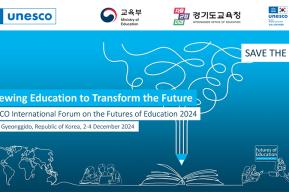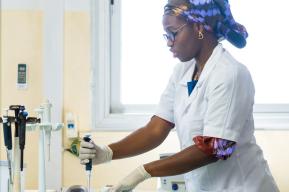News
Meet the finalists of the 2018 UNESCO prize for innovation in education

Left to right: CAYSTI, Eneza Education, Mubakkir, Innovation Lab Schools, Hello World Kids (photo © Hello World Kids,), KA TECHNOLOGIES, Rumie, Mindspark (photo © Educational Initiatives Pvt. Ltd.)
The ThingLink visual learning technology from Finland and the Can’t Wait to Learn programme from the Netherlands were awarded the 2018 UNESCO King Hamad Bin Isa Al-Khalifa Prize, which recognizes the innovative use of technology in education. Along with the two laureates, the International Jury of the Prize selected eight finalists:
Mindspark Learning Labs - Making Learning with Understanding a Possibility for All, Educational Initiatives Pvt. Ltd., India
Mindspark is an online learning tool, which aims to offer a personalised and adaptive learning experience to students. Started in 2008 by Educational Initiatives (EI), an India-based social enterprise, the project was developed to answer to declining student outcomes in the country, despite improvements in access to education.
Covering Math and Language in English, Hindi and Gujarati, Mindspark is based over a decade of research on how students learn. Using data on students’ strengths and weaknesses, the program tries to remedy their learning gaps through questions and games tailored to meet the children’s needs and learning pace. It also tries to provide relevant content to challenge their current knowledge and therefore maximise learning outcomes.
Recent tests conducted on students using Mindspark showed promising learning outcome improvements. It is currently being used in over 400 public and private schools across six Indian states.
Improving Basic Education through Teachers using SMS & USSD, Eneza Education, Ghana
Eneza has developed a technology platform that allows primary and secondary students, their parents, and teachers to access local, relevant, affordable academic courses and study tools by SMS, online and mobile applications. With Eneza, students have the ability to supplement their classroom studies at home by taking lessons and assessments with individualized feedback on correct and incorrect answers. They can also access additional sources of educational content, such as Wikipedia, and tutoring, by asking questions to live teachers.
Using the platform, learners score 22.7% higher than peers not on Eneza, with 97% of users mentioning improved scores. There are currently over 4.9 million registered users with an active subscriber base of 400,000 across Africa.
Connecting the disconnected to a quality digital education, the Rumie Initiative, Canada
Based in Toronto, Canada, the Rumie initiative is a non-profit tech organization, which was founded in 2013 to help give access to quality digital learning resources for communities with little or no Internet access. Such communities include refugee settings; conflict and crisis situations; new immigrant programs; remote and rural regions; and Indigenous communities.
Rumie’s approach consists of an online repository of high-quality, digital, educational content, which is crowdsourced by educators and passionate volunteers. In cooperation with on-the-ground program partners, Rumie then selects the most relevant learning material for each specific context and loads that content onto the specialized Rumie Tablet or any personal Android device via the Rumie App for offline use. The Tablet and App also collect analytics to get feedback on which content is the most valuable to the learners to customize the learning experience further.
The program is currently being used in 28 countries, impacting over 35,000 learners globally, and aims to reach 500,000 learners by 2020, and over 50 million by 2028.
Projet Numérique et Energie renouvelable pour porter l’éducation partout et pour tous, Société KA TECHNOLOGIES France SAS, Togo
KA Technologies is a digital company aiming to leverage technology to address the educational gap in southern as well as northern countries. Its main project is RETICE-PWCS (for “Réseau Energie et TIC pour l’Education et Entreprise” and “Polyvalent Wireless Communication System”) which aims to promote the use of digital technology for students, teachers, and companies. It has been already tested in Togo and other African countries.
RETICE can work offline and offers access to shared educational resources. It can be easily adapted to K-12 and universities. The tablet can also be used for management purposes within companies due to its user friendly and effective data storage on a local network. With this device, any school, home, or company, with or without electricity, can benefit from high-quality and secure digital coverage. It ensures the continuation of education, even in disadvantaged and remote areas.
Mubakkir Arabic Language Early Literacy Assessment, Diglossia FZ, LLC, United Arab Emirates
Developed by Diglossia, a USA-UAE company, in collaboration with the Lebanon-based NGO Arab Thought Foundation, and the Aribi21 Project, the Mubakkir is the first mobile app and online test to measure literacy development of Arabic early language learners.
The test is based on the Arabic Reading Level Standards and can be used by both native and non-native speakers. Mubakkir is designed to promote early literacy skills in young learners and takes part in the foundation’s effort to improve teaching and learning of the language by providing standards, materials, tools and support throughout the Arab World. It also helps schools and teachers to make decisions about reading instructions, provide individualized and early support for at-risk or struggling readers and prevent the occurrence of later reading difficulties.
National Camp for Coding, Robotics, and Entrepreneurship for Underserved Youth, CAYSTI, Cameroon
Created by Arielle Kitio in Cameroon, CAYSTI is an organization dedicated to fostering equal access to education through technology in developing countries. Specifically, it aims to develop students’ creativity, autonomy and digital skills by offering personalized educational programmes such as abcCode. abcCode is an intelligent e-learning platform initiating children to creative programming and robotics in their national languages. Using gamification to develop students’ problem-solving and critical thinking abilities, this programme also teaches learners the language of coding while using their own language and culture, as a mean to reinforce their feeling of cultural belonging.
More than 6,000 children have benefited from this program since 2017 and CAYSTI is currently working with the government and other partners to spread across the country and throughout Africa.
Hello World Kids, Jordan
Started in 2015 by the Jordanian entrepreneur Hanan Khader, Hello World Kids was built with the goal to teach programming and coding to children from a young age. It enables schools to include those disciplines in their core academic curriculum and provides them with an online learning platform: HelloCode.me.
Hellocode.me gives children the opportunity to practice coding by taking a storytelling approach and simplify programming concepts to progressively build up their analytical thinking and problem solving skills. Hello World Kids also developed a new programming language, SmoothY, designed specifically for kids.
Innovation Lab Schools, Help Kakuma vzw, Belgium
Innovation Lab Schools is a network of educators that seeks to improve education for students in rural areas of Africa by connecting them with teachers via video conferencing. The project was initiated in 2015 in the refugee camp of Kakuma where Koen Timmers, director and founder of Innovation Lab Schools, started teaching students via Skype. This led to more teachers joining the project with now 350 teachers across 75 countries offering free Skype lessons in Math, Science and English.
After a successful Climate Action project in 2017 involving students from 91 countries, Koen Timmers decided to scale up the project by building Innovation Lab Schools in 12 countries. Aiming to reach 1 million students by 2022, the project offers its own curriculum based on the United Nations Sustainable Development Goals, available in 12 languages. Besides connecting teachers and students, it also connects students from around the world who will be able to collaborate, from the favelas in Brazil to the jungle of Tanzania.








